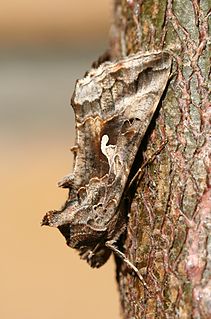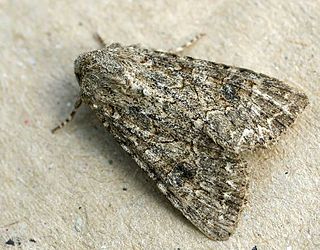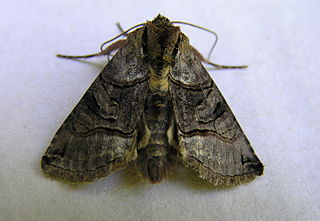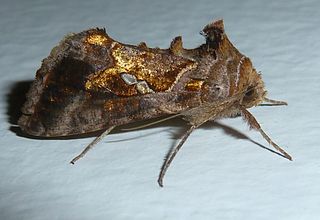
The Noctuidae, commonly known as owlet moths, cutworms or armyworms, are the most controversial family in the superfamily Noctuoidea because many of the clades are constantly changing, along with the other families of the Noctuoidea. It was considered the largest family in Lepidoptera for a long time, but after regrouping Lymantriinae, Catocalinae and Calpinae within the family Erebidae, the latter holds this title now. Currently, Noctuidae is the second largest family in Noctuoidea, with about 1,089 genera and 11,772 species. However, this classification is still contingent, as more changes continue to appear between Noctuidae and Erebidae.

Xestia is a genus of noctuid moths. They are the type genus of the tribe Xestiini in subfamily Noctuinae, though some authors merge this tribe with the Noctuini. Species in this genus are commonly known as "clays", "darts" or "rustics", but such names are commonplace among Noctuidae. Xestia moths have a wide distribution, though they most prominently occur in the Holarctic.

Schinia, commonly called flower moths, is a large genus of moths belonging to the family Noctuidae. The genus has a Holarctic distribution with the vast majority of species being found in North America, many with a very restricted range and larval food plant.

Plusiinae is a smallish subfamily of the moth family Noctuidae. As the Noctuidae appear to be a paraphyletic assemblage, the Plusiinae may eventually be raised to family status.

Hadeninae is a subfamily of moth family Noctuidae. The limits between this group and the Condicinae and Noctuinae are still not precisely known, with 3 major and partially conflicting revisions since 2006. Some include the noctuid subfamilies Eriopinae and Psaphidinae here as tribes Eriopini and Psaphidini, yet the former are not even recognized as distinct tribe by all sources. Another proposed treatment is to include the group within an expanded Noctuidae.

Abrostola tripartita is a moth of the family Noctuidae. It is found throughout much of the Palearctic realm including all Europe, Russia, Siberia Amur, Kyrgyzstan, and Kazakhstan.

Acronictinae is a large subfamily of moths in the family Noctuidae.

The Tomato Looper or golden twin-spot moth(Chrysodeixis chalcites) is a moth of the family Noctuidae, subfamily Plusiinae. It is found from southern Europe, the Levant and tropical Africa, but can be found in great parts of Europe because it is a migratory species. It has also recently been reported from North America.
Conochuza is a monotypic moth genus of the family Noctuidae. Its only species, Conochuza lineola, is known from the Seychelles. Both the genus and species were first described by Emilio Berio in 1962.
Protomeroleuca is a monotypic genus of moths of the family Noctuidae. It contains only the species Protomeroleuca perlides Berio, 1966 from Madagascar.

Heliothinae is a small subfamily of moths in the family Noctuidae. There are about 400 species described worldwide. They are found predominantly in semiarid subtropical habitats.

The Erebidae are a family of moths in the superfamily Noctuoidea. The family is among the largest families of moths by species count and contains a wide variety of well-known macromoth groups. The family includes the underwings (Catocala); litter moths (Herminiinae); tiger, lichen, and wasp moths (Arctiinae); tussock moths (Lymantriinae), including the arctic woolly bear moth ; piercing moths ; micronoctuoid moths (Micronoctuini); snout moths (Hypeninae); and zales, though many of these common names can also refer to moths outside the Erebidae. Some of the erebid moths are called owlets.

The Erebinae are a subfamily of moths in the family Erebidae erected by William Elford Leach in 1815. Erebine moths are found on all continents except Antarctica, but reach their greatest diversity in the tropics. While the exact number of species belonging to the Erebinae is not known, the subfamily is estimated to include around 10,000 species. Some well-known Erebinae include underwing moths (Catocala) and witch moths (Thermesiini). Many of the species in the subfamily have medium to large wingspans, up to nearly 30 cm in the white witch moth, which has the widest wingspan of all Lepidoptera. Erebine caterpillars feed on a broad range of plants; many species feed on grasses and legumes, and a few are pests of castor bean, sugarcane, rice, as well as pistachios and blackberries.
Apamea macronephra is a moth of the family Noctuidae first described by Emilio Berio in 1959. It is found on Madagascar.
Oedebasis mutilata is a moth of the family Erebidae first described by Emilio Berio in 1966. It is known from eastern Madagascar.
Pandesma decaryi is a moth of the family Erebidae. It is native to central & south-western Madagascar.
Emilio Berio was an Italian entomologist and lawyer.
Fodina afflicta is a moth in the family Noctuidae. It is found in Madagascar.
Fodina viettei is a moth in the family Erebidae. It is found in north-western Madagascar.
Apothriguna is a monotypic moth genus of the family Nolidae. Its only species, Apothriguna legrandi, is endemic to the island of Mahé in the Seychelles. Both the genus and species were first described by Emilio Berio in 1962.










